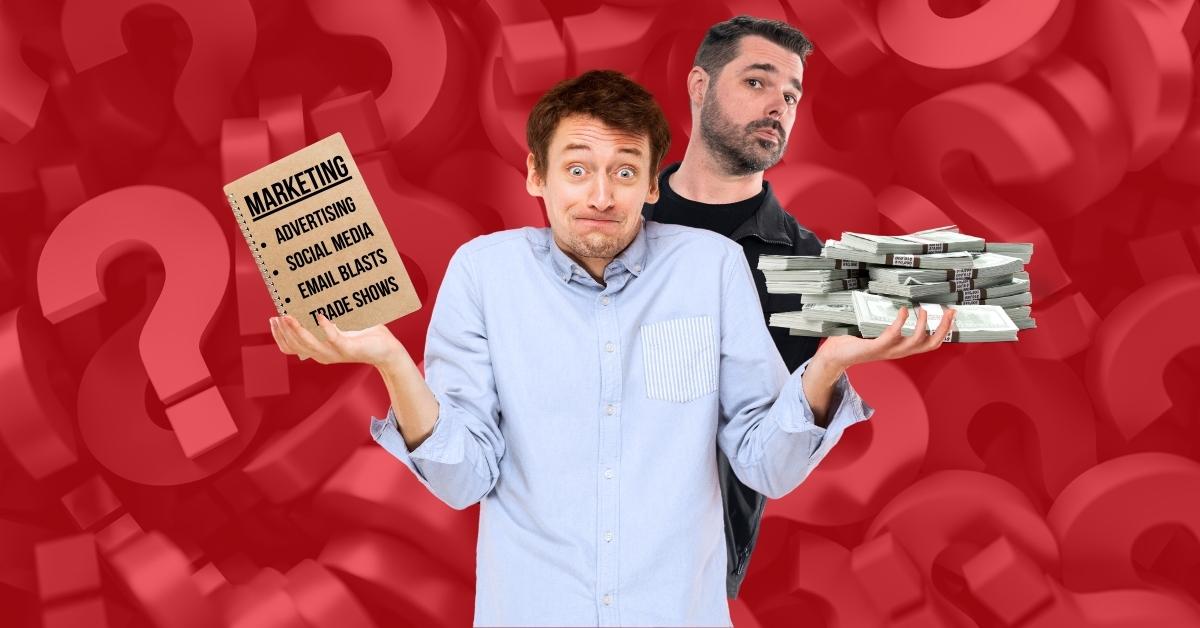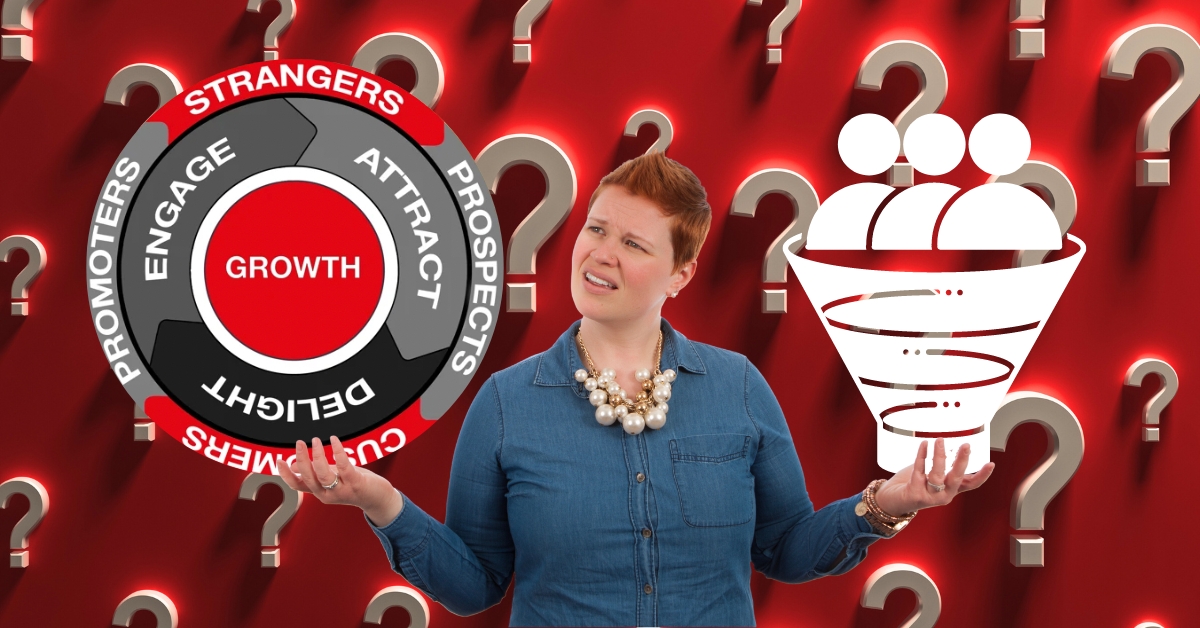How Much Should Your Business Spend on Marketing?
As a small business owner, you recognize the significance of marketing in fueling the growth of your business and attracting customers. However,...

Simply put, inbound is a philosophy in marketing that focuses on creating helpful content for your audience, causing them to view your brand as a valuable resource. This helps to convert members of your audience into qualified, inbound leads for your sales team. If you’ve ever worked in sales, you’ll likely agree that inbound leads are the best type of leads. With inbound leads, you don’t have to chase the customer, the customer comes to you.
.png?width=150&name=Untitled%20design%20(44).png) By providing useful answers and valuable resources to your audience, without requiring them to become a customer first, a company is able to position themselves as a trusted advisor to their prospects. And because every sale is a race to trust, companies who practice inbound marketing tend to have a much easier time throughout the sales process.
By providing useful answers and valuable resources to your audience, without requiring them to become a customer first, a company is able to position themselves as a trusted advisor to their prospects. And because every sale is a race to trust, companies who practice inbound marketing tend to have a much easier time throughout the sales process.
This approach also leads to less outbound pressure from your sales team to your prospects, and a better overall customer experience. Which leads to happier customers. And happy customers are more likely to spread the word about how great your company is. From there, the cycle continues and starts to build momentum.
Sounds great, right?
So… how do you get started with Inbound Marketing?
.png?width=150&name=Untitled%20design%20(45).png) Well, the first step is to understand your audience. What do they want? What problems are they trying to solve? And what questions are they asking to try to solve those problems?
Well, the first step is to understand your audience. What do they want? What problems are they trying to solve? And what questions are they asking to try to solve those problems?
Don’t expect to just know these answers either. Finding out which problems your customers have is usually a group effort. Your sales team should be seen as a valuable resource here. Since they spend most of their day talking to customers, they’ll have a good idea of the most common questions and problems to be solved.
After that, it’s just a matter of creating content that answers these questions. And making sure that your audience can find it.
-1.png?width=105&name=Untitled%20design%20(46)-1.png) Also… don’t forget they should associate your brand with the answer. You’re trying to be helpful here, but you’re also trying to make a positive impression for your brand so you can convert your audience’s interest into sales.
Also… don’t forget they should associate your brand with the answer. You’re trying to be helpful here, but you’re also trying to make a positive impression for your brand so you can convert your audience’s interest into sales.
Because you’re most likely not the only company out there trying to answer these questions, you may be wondering how you can compete with them.
.png?width=150&name=Untitled%20design%20(47).png)
While your competitors might have gotten the jump on creating content for your common audience, that doesn’t mean they can’t be topped. At Savage Media, we like to use an approach called “The Skyscraper Method” to determine how high the bar has already been set on the content we’re creating.
The Skyscraper Method is pretty simple. It’s based on the constant race between cities to build the tallest skyscraper. Every time it seems like somebody’s won, another goes up just a little bit higher.
If your competitor has an outdated blog article, write a new one that has updated facts and a video to explain things. If they have a PDF guide, make a better one that includes a deeper dive into the topic. If they’ve created a Facebook Group to discuss the topics you’re trying to provide answers for, make a better one.
Standing out from your competition isn’t just a matter of having a louder megaphone. People expect to see real value.
.png?width=150&name=Untitled%20design%20(48).png) With the advent of the internet, buyers are more empowered today than ever. They’re no longer reliant on expert salespeople to guide them towards a purchase. Consumers are able to do their own research on their own terms in order to decide what’s best for them. Don’t waste your time, or better yet your customers' time by reaching out to them uninvited.
With the advent of the internet, buyers are more empowered today than ever. They’re no longer reliant on expert salespeople to guide them towards a purchase. Consumers are able to do their own research on their own terms in order to decide what’s best for them. Don’t waste your time, or better yet your customers' time by reaching out to them uninvited.
By creating helpful content that your customers can use to better their business, whether they decide to become your customer or not, you’ll begin to establish yourself as an authority in the eyes of your prospects. And will be much more likely to gain their trust, and ultimately their business.
Outbound, also known as interruption marketing, is the old way of marketing. It relies on catching your prospect off-guard with a message you want them to hear. Some being:.png?width=150&name=Untitled%20design%20(56).png)
Remember when you used to get cold called, or spammed with emails you didn’t sign up for because someone paid for your information? That’s outbound. And it’s annoying.
.png?width=89&name=Untitled%20design%20(49).png)
The problem with this method is that you can tell it’s inauthentic. There’s no helpful intent behind the content produced. It’s focused purely on getting a sale.
Today, technology is so advanced, the amount of ways we’ve discovered to opt-out of annoying marketing tactics will only continue to grow. We’re now warned when getting spam calls through caller ID, we even have the option to pay a few more dollars to have a commercial free TV subscription. It’s pretty obvious that most people hate having their time wasted on someone trying to sell them something.
.png?width=150&name=Untitled%20design%20(50).png) Not only does it frustrate the potential buyer, but outbound marketing can come off kind of desperate. Of course you want to get your product out in the world, but if a potential buyer is annoyed by the way you market, it could leave a bad taste in their mouth about your company.
Not only does it frustrate the potential buyer, but outbound marketing can come off kind of desperate. Of course you want to get your product out in the world, but if a potential buyer is annoyed by the way you market, it could leave a bad taste in their mouth about your company.
This is the exact opposite of what you want! So why do so many companies keep marketing this way? Sadly, this is the way some companies have always done things and it’s not always easy to change with the times.
Because outbound is out and inbound is in, how do you know the tactics you’re moving over to are the right ones?
I’m glad you asked.
Through inbound marketing you can draw in clientele you’re searching for without bombarding them throughout their day. You can trust that when a potential customer has a problem, their instinctual duty is to hop on the internet and look up some type of question that could help solve their problem. Perfect, how can you answer that question?.png?width=129&name=Untitled%20design%20(51).png)
By using what you already know about your best customers, you can create a fictitious representation of your ideal customer who is the optimal user of your product or service. This will help to inform you on the type of content you should create and who you should create it for.
Start with their demographics; background, goals, and challenges they’re facing. Ask yourself, “What am I solving for the buyer and what would I look up if I was in search of this solution?”. This puts you in their shoes and helps you understand how they want to be marketed to. Making those potential buyers feel like they’re being catered to and not just another name on a call sheet may be the difference in whether they choose you or the competition.
-1.png?width=103&name=Untitled%20design%20(52)-1.png)
The concept of an ideal customer can help guide the direction you want your content to go. When the content you produce aligns with the problems your customers face, it’ll be easier to form lasting relationships with your customers. If a customer asks a question, they should get the same answer every time, no matter who they’re talking to. You want them to trust what you’re saying and why you’re saying it. Take out the confusion within your company, check out the flywheel model to understand how happy customers can help your business grow.
The buyer wants to find you organically and be in control of the situation. You can help them feel in control by using SEO and keywords in your content to show up in their search. These tools help search engines know what your content is about and will make it relevant to the question the potential buyer is asking. By showing up in their search, they immediately feel in control of the situation. They found you not the other way around. This is the power they’re looking for.
.png?width=150&name=Untitled%20design%20(53).png) First off, make sure you have an up-to-date website that you have complete control of. This is where your audience will end up when they are in the beginning stages of the buyer’s journey. A place they can go 24/7 to get answers.
First off, make sure you have an up-to-date website that you have complete control of. This is where your audience will end up when they are in the beginning stages of the buyer’s journey. A place they can go 24/7 to get answers.
A website used to be a simple brochure about your company. What you saw is what you got, it was static and never changing. Now, they’re ever changing. They can be updated and share a perspective that helps you constantly grow your content. And that’s what the public wants, they want to go to your site and feel like they know you. They want to feel connected to your company in some way, with a mutual feeling of trust and understanding. In reality, they just want to feel seen and validated in the problem they need solved.
Content should be made specific to your brand and what the public needs to know about your company and what it has to offer. Everyone wants to see things that are visually appealing, make your audience feel encapsulated by your content so they feel they have no choice but to learn more.
.png?width=122&name=Untitled%20design%20(54).png)
If you’re not consistently creating content, you’re doing it wrong! This will be a crucial part of your SEO. Make your posts specific to the questions your audience needs answered. The goal is to create topical relevance. Stay on track with your ideal customer, they are your target audience and you need to focus on their problems.
After you’ve created your content, you can see which items are performing best. Use that information to your advantage, see what your audience found most interesting and rework it. Continue to break that piece down for different types of micro-media and drive more traffic to that specified piece.
.png?width=102&name=Untitled%20design%20(57).png) A “call to action” is crucial when turning prospects to customers. They came to your site because they have a serious problem they want solved. Keep your CTA relevant to the content your viewers just saw. After they’ve seen what you have to offer, you should give them the option to move towards the next steps of solving that problem.
A “call to action” is crucial when turning prospects to customers. They came to your site because they have a serious problem they want solved. Keep your CTA relevant to the content your viewers just saw. After they’ve seen what you have to offer, you should give them the option to move towards the next steps of solving that problem.
Other ways to Inbound:
Creating an inbound marketing strategy can be a lot of work, but in the end it’s totally worth it. Not only are you giving your ideal customer answers to the questions they have, but you’re creating content essential for your business you can use over and over again.
.png?width=150&name=Untitled%20design%20(55).png) There’s value in working with someone to help you through this process if you have no time to do it yourself. Considering that’s what inbound marketing does… frees up your time, seems kind of silly you’re even questioning if you should be adopting it. You won’t be spending all day making cold calls hoping to catch a few “yes’s” in a sea of “no’s.” You’ll be so busy with all the warm leads coming in, you'll ask yourself why you haven’t been inbounding all along.
There’s value in working with someone to help you through this process if you have no time to do it yourself. Considering that’s what inbound marketing does… frees up your time, seems kind of silly you’re even questioning if you should be adopting it. You won’t be spending all day making cold calls hoping to catch a few “yes’s” in a sea of “no’s.” You’ll be so busy with all the warm leads coming in, you'll ask yourself why you haven’t been inbounding all along.
If you’re in need of help with your inbound marketing strategy, the experts at Savage Media can get you started and give you more time to close actual prospects while taking a methodical approach.

As a small business owner, you recognize the significance of marketing in fueling the growth of your business and attracting customers. However,...

According to Oberlo, there will be over 4.4 billion social media users by 2025. If your business is not utilizing social media as a marketing tool...

If your company has goals and objectives there needs to be a system in place to help you reach them.